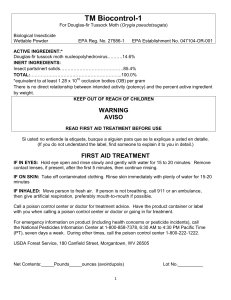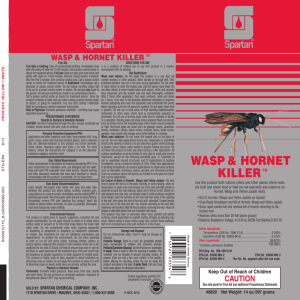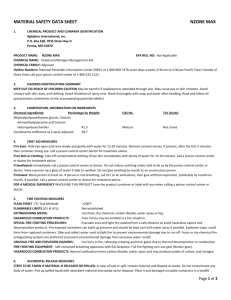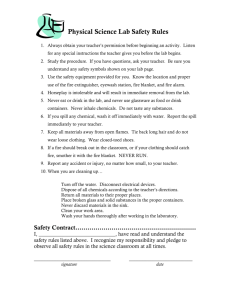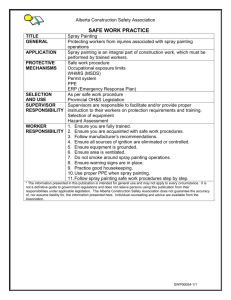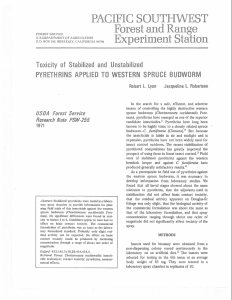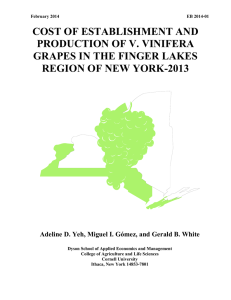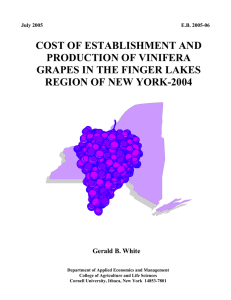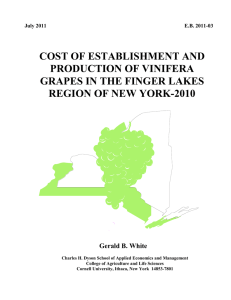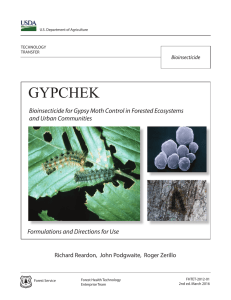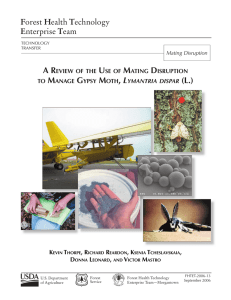Gypchek
advertisement
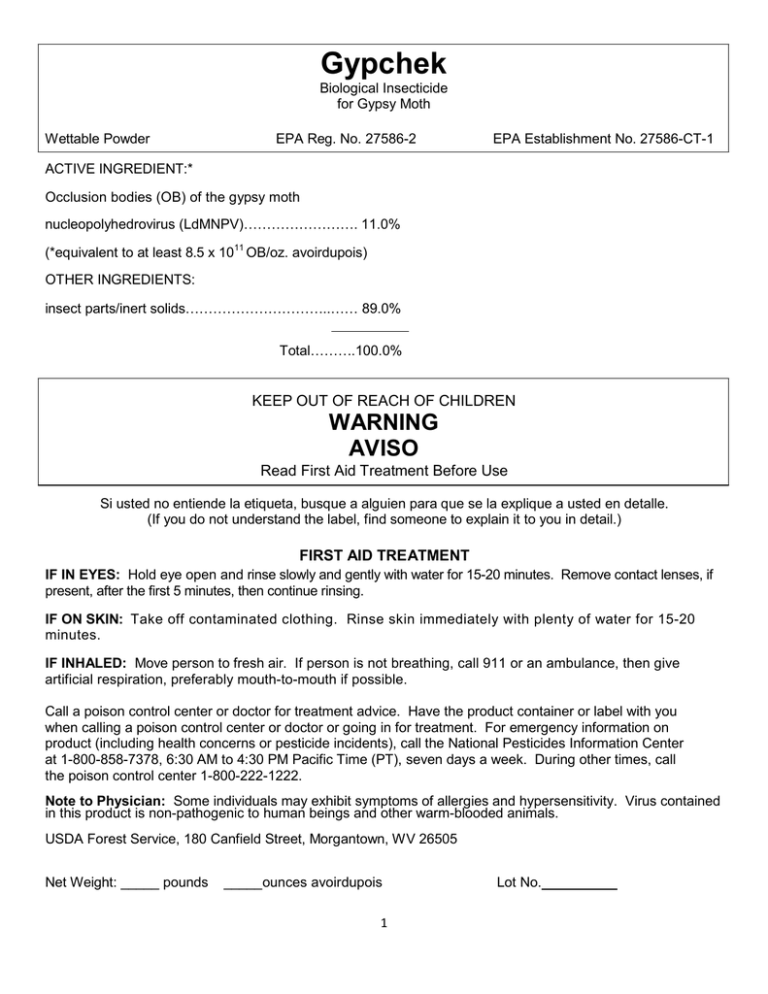
Gypchek Biological Insecticide for Gypsy Moth Wettable Powder EPA Reg. No. 27586-2 EPA Establishment No. 27586-CT-1 ACTIVE INGREDIENT:* Occlusion bodies (OB) of the gypsy moth nucleopolyhedrovirus (LdMNPV)……………………. 11.0% (*equivalent to at least 8.5 x 1011 OB/oz. avoirdupois) OTHER INGREDIENTS: insect parts/inert solids…………………………..…… 89.0% Total……….100.0% KEEP OUT OF REACH OF CHILDREN WARNING AVISO Read First Aid Treatment Before Use Si usted no entiende la etiqueta, busque a alguien para que se la explique a usted en detalle. (If you do not understand the label, find someone to explain it to you in detail.) FIRST AID TREATMENT IF IN EYES: Hold eye open and rinse slowly and gently with water for 15-20 minutes. Remove contact lenses, if present, after the first 5 minutes, then continue rinsing. IF ON SKIN: Take off contaminated clothing. Rinse skin immediately with plenty of water for 15-20 minutes. IF INHALED: Move person to fresh air. If person is not breathing, call 911 or an ambulance, then give artificial respiration, preferably mouth-to-mouth if possible. Call a poison control center or doctor for treatment advice. Have the product container or label with you when calling a poison control center or doctor or going in for treatment. For emergency information on product (including health concerns or pesticide incidents), call the National Pesticides Information Center at 1-800-858-7378, 6:30 AM to 4:30 PM Pacific Time (PT), seven days a week. During other times, call the poison control center 1-800-222-1222. Note to Physician: Some individuals may exhibit symptoms of allergies and hypersensitivity. Virus contained in this product is non-pathogenic to human beings and other warm-blooded animals. USDA Forest Service, 180 Canfield Street, Morgantown, WV 26505 Net Weight: _____ pounds _____ounces avoirdupois 1 Lot No. PRECAUTIONARY STATEMENTS Hazards to Humans & Domestic Animals WARNING Causes substantial but temporary eye injury. Do not get in eyes or on clothing. Wear goggles or a face shield. Harmful if absorbed through the skin. Avoid contact with skin. Wash thoroughly with soap and water after handling and before eating, drinking, chewing gum, using tobacco or using the toilet. Remove and wash contaminated clothing before reuse. Repeated exposure to high concentration of microbial proteins can cause allergic sensitization. Personal Protective Equipment (PPE) Mixers must use protective eyewear (goggles or face shield). Mixers, loaders, applicators and other handlers must wear: • • • • Long-sleeved shirt and long pants Shoes plus socks Waterproof gloves a dust/mist filtering respirator meeting NIOSH standards of at least N-95, R-95 or P-95, when working outside of a protective enclosed cab or aircraft cockpit. After product is diluted in accordance with directions for use, protective eyewear is not required. Follow manufacturer’s instructions for cleaning and maintaining PPE. If no such instructions for washables, use detergent and hot water. Keep and wash PPE separately from other laundry. User Safety Recommendations Wash the outside of gloves before removing. Remove PPE immediately after handling this product. As soon as possible, wash thoroughly and change into clean clothing. Work in open or well-ventilated areas. Users should remove clothing/PPE immediately if pesticide gets inside. Then wash thoroughly and put on clean clothing. Environmental Hazards For terrestrial uses: Except under the forest canopy, do not apply directly to water or to areas where surface water is present or to intertidal areas below the mean high water mark. Do not contaminate water when cleaning equipment or disposing of equipment washwaters or rinsate. Do not discharge effluent containing this product into lakes, streams, ponds, estuaries, oceans, or other waters unless in accordance with the requirements of a National Pollutant Discharge Elimination System (NPDES) permit and the permitting authority has been notified in writing prior to discharge. Do not discharge effluent containing this product to sewer systems without previously notifying the local sewage treatment plant authority. For guidance contact your State Water Board or Regional Office of the EPA. 2 DIRECTIONS FOR USE It is a violation of Federal law to use this product in a manner inconsistent with its labeling. Product Information: Gypchek contains a virus specific to the gypsy moth, Lymantria dispar (L.). Maximum effectiveness is exhibited against early instar larvae after consumption of a lethal dose. Spray application should occur soon after egg hatch is complete and all larvae have migrated from the egg mass; the majority of late-first instar are actively feeding; and when the target foliage is at least 20% expanded. Best results are expected when applications are made onto dry foliage with winds less than 10 mph. Eradication projects and/or rainy weather may necessitate more than 2 applications per year. Spray application is not recommended if rain is predicted within 12 hours. Use Restrictions: Only for use as a biological insecticide to manage gypsy moth infestations in widearea public pest control programs sponsored by government entities. Application of this product is limited to forest trees and ornamental or non-commercial trees in urban parks, golf courses, lawns and landscapes. Tree species include but not limited to oak, hickory, basswood, birch, cherry, elm, blackgum, larch, sassafras, hemlock, cedar, spruce, black walnut, American chestnut, willow, ash, boxelder, hawthorn, butternut, catalpa, locust, and sycamore. This product is sensitive to environmental conditions. Store product in a cool dark place prior to use (read STORAGE AND DISPOSAL section). Mixing Instructions: Add Gypchek to recommended carrier in the proper ratio for per acre dosages and agitate to maintain suspension. Consult USDA Forest Service, Northeastern Research Station, Hamden, CT, tel: (203) 230-4325 for currently recommended adjuvants in tank mix. Use clean water as a diluent, but never use chlorinated water in the spray formulation. If pH of diluent water for mixing is less than 5.5 or greater than 7.5, add appropriate amount of acid or base with products available for swimming pools to adjust to within acceptable pH range. Observe the most restrictive of the labeling limitations and precautions of all products used in mixtures if product is mixed with other pesticides. Consult USDA Forest Service (tel: (203) 230-4325) for information on compatibility and effectiveness prior to mixing this pesticide with any other. Application Instructions Ground Application: Apply up to 1.174 oz., or 33.3 g, of Gypchek (i.e. 1.0 x 1012 OB) per acre, one or more times, with high volume hydraulic sprayers at a rate of 100 gallons of tank mix per acre to woodlots and small acreages. Individual large trees should be sprayed once to runoff. Aerial Application: For single application to a site, apply 0.469 oz., or 13.3 g, of Gypchek (i.e. 4.0 x 1011 OB) per acre for suppression, and 1.174 oz., or 33.3 g, of Gypchek (i.e. 1.0 x 1012 OB) per acre for eradication. For two or more applications to a site, apply up to 0.236 oz., or 6.7 g, of Gypchek (i.e. 2.0 x 1011 OB) per acre per application for suppression, and 0.589 oz., or 16.7 g, of Gypchek (i.e. 5.0 x 1011 OB) per acre per application for eradication, with 2 to 4 days between applications. Depending upon type of carrier, use ½ to 2 gallons of tank mix volume per acre. Aerial Spray Drift Reduction: Avoiding spray drift from the application site is the responsibility of the applicator. The interaction of many equipment- and weather-related factors determine the potential for spray drift. The applicator is responsible for considering these factors when making application decisions. Observe local regulations for spray drift reduction. 3 STORAGE AND DISPOSAL Do not contaminate water, food, or feed by storage and disposal. Storage & Transport: Activity will be impaired by exposure to direct sunlight or temperatures above 90º F. Store in sealed containers in cool dry place. Temperatures below 32º F are advantageous for long-term storage. Locked storage should provide separation of pesticides and prevent cross-contamination of other pesticides, fertilizer, food, and feed. Transport in sealed storage container and locate in a compartment separate from passengers and driver. Pesticide Disposal: Wastes resulting from the use of this product must be disposed of on site or at an approved waste disposal facility. Container Handling: Nonrefillable container. Do not reuse or refill this container. Completely empty bag into application equipment by shaking and tapping sides and bottom to loosen clinging particles. When completely empty, offer for recycling if available, or dispose of bag in a sanitary landfill or by incineration or, if allowed by State and local authorities, by burning. If burned, stay out of smoke. NOTICE USDA Forest Service neither makes, nor authorizes any agent or representative to make any warranty, guarantee, or representation, express or implied, of merchantability and/or fitness concerning this material except those contained on the label. 4
